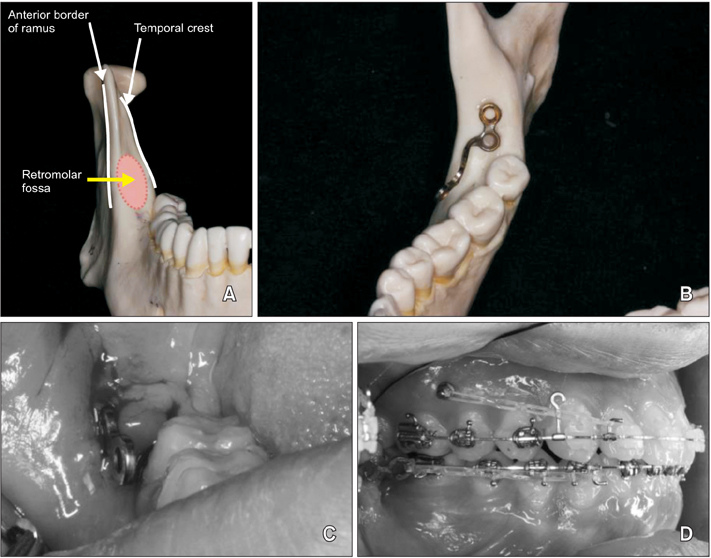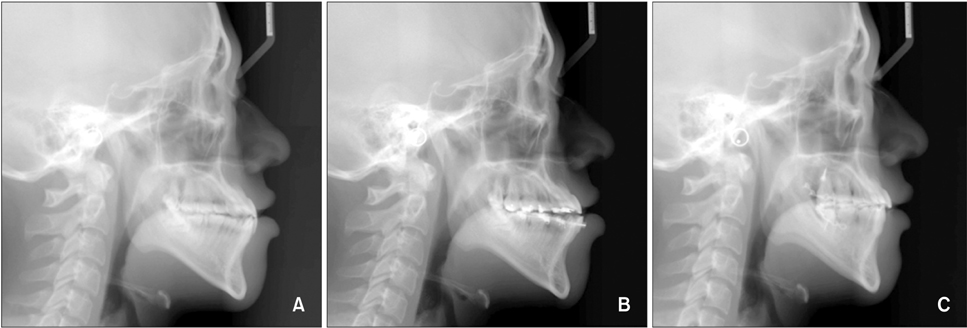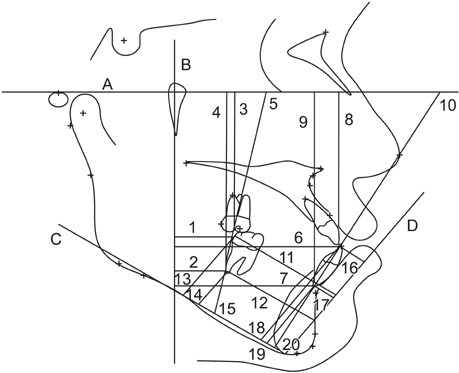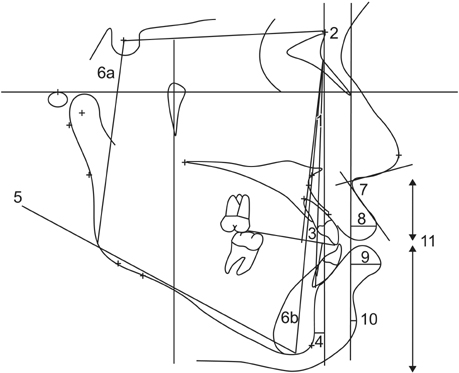Korean J Orthod.
2016 Jul;46(4):212-219. 10.4041/kjod.2016.46.4.212.
Treatment effects of mandibular total arch distalization using a ramal plate
- Affiliations
-
- 1Department of Orthodontics, Graduate School of Clinical Dental Science, The Catholic University of Korea, Seoul, Korea.
- 2Postgraduate Orthodontic Program, Arizona School of Dentistry & Oral Health, A.T. Still University, Mesa, AZ, USA.
- 3Graduate School of Dentistry, Kyung Hee University, Seoul, Korea.
- 4Department of Dentistry, Graduate School, The Catholic University of Korea, Seoul, Korea.
- 5Department of Postgraduate Studies, the Universidad Autonóma del Paraguay, Asunción, Paraguay.
- 6Department of Orthodontics, Seoul St. Mary's Hospital, College of Medicine, The Catholic University of Korea, Seoul, Korea.
- 7Department of Oral and Maxillofacial Surgery, Seoul St. Mary's Hospital, College of Medicine, The Catholic University of Korea, Seoul, Korea. omfskim1@catholic.ac.kr
- KMID: 2392201
- DOI: http://doi.org/10.4041/kjod.2016.46.4.212
Abstract
OBJECTIVE
The purpose of this study was to evaluate treatment effects after distalization of the mandibular dentition using ramal plates through lateral cephalograms.
METHODS
Pre- and post-treatment lateral cephalograms and dental casts of 22 adult patients (11 males and 11 females; mean age, 23.9 ± 5.52 years) who received ramal plates for mandibular molar distalization were analyzed. The treatment effects and amount of distalization of the mandibular molars were calculated and tested for statistical significance. The significance level was set at p < 0.001.
RESULTS
The mandibular first molar distalization at the crown and root were 2.10 mm (p < 0.001) and 0.81 mm (p = 0.011), respectively. In the evaluation of skeletal variables, there was a significant increase in the Wits appraisal (p < 0.001). In the evaluation of the soft tissue, there was no significant effect on upper lip position, but the lower lips showed a significant retraction of 2.2 mm (p < 0.001).
CONCLUSIONS
The mandibular molars showed a significant amount of distalization accompanied by limited extrusion and mesiobuccal rotation of the crowns. A ramal plate may be a viable device for mandibular total arch distalization in Class III patients who are reluctant to undergo orthognathic surgery.
Figure
Cited by 2 articles
-
Mandibular skeletal posterior anatomic limit for molar distalization in patients with Class III malocclusion with different vertical facial patterns
Sung-Ho Kim, Kyung-Suk Cha, Jin-Woo Lee, Sang-Min Lee
Korean J Orthod. 2021;51(4):250-259. doi: 10.4041/kjod.2021.51.4.250.Characterization of facial asymmetry phenotypes in adult patients with skeletal Class III malocclusion using three-dimensional computed tomography and cluster analysis
Sang-Woon Ha, Su-Jung Kim, Jin-Young Choi, Seung-Hak Baek
Korean J Orthod. 2022;52(2):85-101. doi: 10.4041/kjod.2022.52.2.85.
Reference
-
1. Kim YH, Han UK, Lim DD, Serraon ML. Stability of anterior openbite correction with multiloop edgewise archwire therapy: A cephalometric follow-up study. Am J Orthod Dentofacial Orthop. 2000; 118:43–54.
Article2. Janson G, de Souza JE, Alves Fde A, Andrade P Jr, Nakamura A, de Freitas MR, et al. Extreme dentoalveolar compensation in the treatment of Class III malocclusion. Am J Orthod Dentofacial Orthop. 2005; 128:787–794.
Article3. Saito I, Yamaki M, Hanada K. Nonsurgical treatment of adult open bite using edgewise appliance combined with high-pull headgear and class III elastics. Angle Orthod. 2005; 75:277–283.4. Byloff F, Darendeliler MA, Stoff F. Mandibular molar distalization with the Franzulum Appliance. J Clin Orthod. 2000; 34:518–523.5. Celentano G, Longobardi A, Cannavale R, Perillo L. Mandibular lip bumper for molar torque control. Prog Orthod. 2011; 12:90–92.
Article6. Kinzinger G, Gross U, Diedrich P. Fixed lingual arch appliance for compliance-free unilateral molar distalization in the mandible. Three case studies. J Orofac Orthop. 2000; 61:440–450.
Article7. O'Donnell S, Nanda RS, Ghosh J. Perioral forces and dental changes resulting from mandibular lip bumper treatment. Am J Orthod Dentofacial Orthop. 1998; 113:247–255.8. Muse DS, Fillman MJ, Emmerson WJ, Mitchell RD. Molar and incisor changes with Wilson rapid molar distalization. Am J Orthod Dentofacial Orthop. 1993; 104:556–565.
Article9. Chung KR, Ahn HW, Kim SJ, Lee KB, Kim SH. Correction of collapsed occlusion with degenerative joint disease focused on the mandibular arch and timely relocation of a miniplate. Am J Orthod Dentofacial Orthop. 2012; 141:e53–e63.
Article10. Jing Y, Han X, Guo Y, Li J, Bai D. Nonsurgical correction of a Class III malocclusion in an adult by miniscrew-assisted mandibular dentition distalization. Am J Orthod Dentofacial Orthop. 2013; 143:877–887.
Article11. Poletti L, Silvera AA, Ghislanzoni LT. Dentoalveolar class III treatment using retromolar miniscrew anchorage. Prog Orthod. 2013; 14:7.
Article12. Sugawara J, Daimaruya T, Umemori M, Nagasaka H, Takahashi I, Kawamura H, et al. Distal movement of mandibular molars in adult patients with the skeletal anchorage system. Am J Orthod Dentofacial Orthop. 2004; 125:130–138.
Article13. Sugawara Y, Kuroda S, Tamamura N, Takano-Yamamoto T. Adult patient with mandibular protrusion and unstable occlusion treated with titanium screw anchorage. Am J Orthod Dentofacial Orthop. 2008; 133:102–111.
Article14. Kook YA, Park JH, Bayome M, Kim S, Han E, Kim CH. Distalization of the mandibular dentition with a ramal plate for skeletal Class III malocclusion correction. Am J Orthod Dentofacial Orthop. 2016; In press.
Article15. Ryu HK, Chong HJ, An KY, Kang K. Short-term and long-term treatment outcomes with Class III activator. Korean J Orthod. 2015; 45:226–235.
Article16. Suh HY, Lee SJ, Park HS. Use of mini-implants to avoid maxillary surgery for Class III mandibular prognathic patient: a long-term post-retention case. Korean J Orthod. 2014; 44:342–349.
Article17. Park J, Cho HJ. Three-dimensional evaluation of interradicular spaces and cortical bone thickness for the placement and initial stability of microimplants in adults. Am J Orthod Dentofacial Orthop. 2009; 136:314.e1–314.e12.
Article18. Poggio PM, Incorvati C, Velo S, Carano A. "Safe zones": a guide for miniscrew positioning in the maxillary and mandibular arch. Angle Orthod. 2006; 76:191–197.19. Ludwig B, Glasl B, Kinzinger GS, Lietz T, Lisson JA. Anatomical guidelines for miniscrew insertion: Vestibular interradicular sites. J Clin Orthod. 2011; 45:165–173.20. Chang C, Liu SS, Roberts WE. Primary failure rate for 1680 extra-alveolar mandibular buccal shelf mini-screws placed in movable mucosa or attached gingiva. Angle Orthod. 2015; 85:905–910.
Article21. Chen YJ, Chang HH, Huang CY, Hung HC, Lai EH, Yao CC. A retrospective analysis of the failure rate of three different orthodontic skeletal anchorage systems. Clin Oral Implants Res. 2007; 18:768–775.
Article22. Schätzle M, Männchen R, Zwahlen M, Lang NP. Survival and failure rates of orthodontic temporary anchorage devices: a systematic review. Clin Oral Implants Res. 2009; 20:1351–1359.
Article23. Park HS, Lee SK, Kwon OW. Group distal movement of teeth using microscrew implant anchorage. Angle Orthod. 2005; 75:602–609.24. Oh YH, Park HS, Kwon TG. Treatment effects of microimplant-aided sliding mechanics on distal retraction of posterior teeth. Am J Orthod Dentofacial Orthop. 2011; 139:470–481.
Article25. Ye C, Zhihe Z, Zhao Q, Ye J. Treatment effects of distal movement of lower arch with miniscrews in the retromolar area compared with miniscrews in the posterior area of the maxillary. J Craniofac Surg. 2013; 24:1974–1979.
Article26. Baumrind S, Frantz RC. The reliability of head film measurements. 1. Landmark identification. Am J Orthod. 1971; 60:111–127.27. Ahlqvist J, Eliasson S, Welander U. The cephalometric projection. Part II. Principles of image distortion in cephalography. Dentomaxillofac Radiol. 1983; 12:101–108.28. Bilecenoglu B, Tuncer N. Clinical and anatomical study of retromolar foramen and canal. J Oral Maxillofac Surg. 2006; 64:1493–1497.
Article29. Rossi AC, Freire AR, Prado GB, Prado FB, Botacin PR, Caria PHF. Incidence of retromolar foramen in human mandibles: ethnic and clinical aspects. Int J Morphol. 2012; 30:1074–1078.
Article30. von Arx T, Hänni A, Sendi P, Buser D, Bornstein MM. Radiographic study of the mandibular retromolar canal: an anatomic structure with clinical importance. J Endod. 2011; 37:1630–1635.
Article
- Full Text Links
- Actions
-
Cited
- CITED
-
- Close
- Share
- Similar articles
-
- Biomechanical analysis of distalization of mandibular molars by placing a mini-plate: A finite element study
- Distalization with a modified C-palatal plate for severe upper crowding and a missing lower incisor
- Comparison of treatment effects between four premolar extraction and total arch distalization using the modified C-palatal plate
- Immediate changes in the mandibular dentition after maxillary molar distalization using headgear
- Biomechanical analysis for different mandibular total distalization methods with clear aligners: A finite element study





